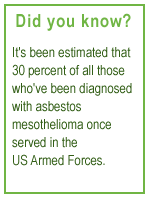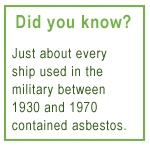Health Effects of Asbestos
www.healtheffectsofasbestos.com
Home >> Veterans
Veterans Asbestos Exposure Risks
 According to the U.S. Department of Veterans Affairs, 25 million people living today have faithfully served in the US Armed Forces. Despite their dedication to their country and (for many) their ability to survive combat, hundreds of thousands of these men and women were exposed to a substance that could kill them: asbestos.
According to the U.S. Department of Veterans Affairs, 25 million people living today have faithfully served in the US Armed Forces. Despite their dedication to their country and (for many) their ability to survive combat, hundreds of thousands of these men and women were exposed to a substance that could kill them: asbestos.
 Asbestos containing materials were used extensively by the military throughout the 20 th century until the 70s, when the dangers of asbestos use could no longer be hidden or denied by companies and organizations benefiting from its use, including the US government. This means that anyone—from plumbers to pipefitters, from sailors to medics—who served in the military prior to the 1970s may have been exposed to asbestos and subsequently developed an asbestos related disease, typically years or even decades after serving.
Asbestos containing materials were used extensively by the military throughout the 20 th century until the 70s, when the dangers of asbestos use could no longer be hidden or denied by companies and organizations benefiting from its use, including the US government. This means that anyone—from plumbers to pipefitters, from sailors to medics—who served in the military prior to the 1970s may have been exposed to asbestos and subsequently developed an asbestos related disease, typically years or even decades after serving.
Asbestos exposure is known to cause a variety of serious and life threatening health effects, including asbestosis, lung cancer, and asbestos mesothelioma. An estimated 30 percent of all those who have been diagnosed with mesothelioma, a rare but aggressive cancer, once served in the US Armed Forces. Because asbestos was used so extensively by the military, virtually anyone who served was at risk for exposure to asbestos.
While virtually every branch of the military used asbestos, some branches and divisions used this material more than others. Read on to learn about asbestos risks posed by serving in the Navy, Coast Guard, and Marines.
Asbestos: Navy and Shipyard Exposure
 While all military branches used asbestos to insulation purposes, the Navy was the primary user of asbestos in the military between the 1930s and 1970s. In fact, virtually every ship and shipyard used by the Navy during this time span was outfitted with myriad asbestos containing products, including:
While all military branches used asbestos to insulation purposes, the Navy was the primary user of asbestos in the military between the 1930s and 1970s. In fact, virtually every ship and shipyard used by the Navy during this time span was outfitted with myriad asbestos containing products, including:
- Brakes
- Gaskets
- Valves
- Insulation
- Flooring, walls, and ceiling materials
- Sound proofing materials
- Heat and fire proofing materials
- Adhesives
- Pipe coverings
- Ropes
- More
These deadly products posed threats not only to those who worked directly with them, but also to any Naval officer; since asbestos containing products could be found in:
- Engine Rooms
- Boiler Rooms
- Navigation rooms
- Sleeping quarters
- Mess halls
- Shipyards
Furthermore, asbestos navy ships could include:
- Battleships
- Amphibious ships
- Auxiliary ships
- Cruisers
- Aircraft carries and airships
- Submarines
- Destroyers and destroyer escorts
- Escort aircraft carriers
- Minesweepers
- Frigates
- Patrol boats
Asbestos: Coast Guard Exposure
Those who served as a member of the Coast Guard prior to the 1970s are at risk for asbestos exposure and subsequent disease for much the same reasons and in much the same ways that Naval Veterans are. Though the Coast Guard serves a different function than the Navy, the Coast Guard's ships and other work environments were outfitted in asbestos-containing products all the same. In fact, all the materials and environments listed above pose the same asbestos exposure and disease risks for Coast Guard as for Navy veterans.
Asbestos: Marine Corps and Army Exposure
While Naval service posed the greatest threat of exposure to asbestos during the course of military duty, Marine Corpsmen and Army service members who served during World War II and into the 1970s may have also been exposed to asbestos on bases and while using specific equipment laden with this strong and durable, yet deadly, substance. It is estimated the US Armed Forces used at least 300 different asbestos containing products throughout the 20 th century, which posed a significant threat of disease to those exposed during their service years.
Asbestos: Air Force Exposure
As the newest member of the US Armed Services, the Air Force did not come into being until 1947. Though this makes for a shorter history relative to other military branches, this does not save Air Force veterans from the risk of asbestos exposure between the branch's inception and the 1970s. Like other branches of the military, the Air Force prized asbestos for its heat and fire proofing abilities, its durability, and more. Air Force veterans could have been exposed to asbestos when they came into contact or worked around the following products and environments:
- boiler rooms and incinerators
- brake linings and pads
- spray coatings and sealants
- concrete (particularly foundations)
- fire retardant clothes, blankets and other equipment
- floor and ceiling tiles
- insulation for buildings and piping
- large machinery used to build and fix planes
- plane engines (particularly the gaskets used in them)
- roofing shingles (such as those used to construct Air Force housing)
- tar
Secondary exposure
An important thing to remember when it comes to veterans and asbestos is that veterans could potentially (and unknowingly) carry harmful asbestos fibers home with them, endangering their loved ones. People who lived with active military members and subsequently developed asbestos-related diseases such as mesothelioma, should understand that this is a likely means of exposure.
Filing an Asbestos Disease VA claim
The U.S. Department of Asbestos Affairs does recognize asbestos mesothelioma as a service-related medical condition. However, while veterans are able to apply for Veteran Affairs (VA) benefits after developing an asbestos related disease, the burden of proof lies on the veteran to compel the VA with substantial evidence that they disease in question was caused by exposure to asbestos during the course of military service. Because of this burden of proof, it can be extremely valuable to seek the help of a veterans benefits legal professional who can help you file a VA claim.
In the unfortunate event you are deemed ineligible to receive VA benefits, you still have several options. Veterans with asbestos mesothelioma or other asbestos diseases can file mesothelioma lawsuits (or asbestos lawsuits ) to seek compensation for their injuries, losses, and suffering. At this time, veterans cannot seek compensation directly from the US government in this type of lawsuit, though you can seek retribution from the makers and suppliers of asbestos containing products used in the military.
When to seek Asbestos Legal Help
If you need help navigating the process of filing a VA claim or would like to learn more about your eligibility for additional support, programs and benefits, a qualified attorney can be an invaluable and reliable resource. It is always a good idea to understand all of the options and benefits available to you, so that you can get the help you need and deserve.